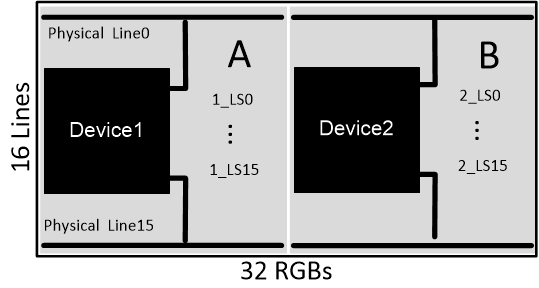ZHCSPI8D November 2021 – July 2022 TLC6984
PRODUCTION DATA
- 1 特性
- 2 应用
- 3 说明
- 4 Revision History
- 5 说明(续)
- 6 Pin Configuration and Functions
- 7 Specifications
-
8 Detailed Description
- 8.1 Overview
- 8.2 Functional Block Diagram
- 8.3
Feature Description
- 8.3.1 Independent and Stackable Mode
- 8.3.2 Current Setting
- 8.3.3 Frequency Multiplier
- 8.3.4 Line Transitioning Sequence
- 8.3.5 Protections and Diagnostics
- 8.4 Device Functional Modes
- 8.5 Continuous Clock Series Interface
- 8.6 PWM Grayscale Control
- 8.7 Register Maps
- 9 Application and Implementation
- 10Power Supply Recommendations
- 11Layout
- 12Device and Documentation Support
- 13Mechanical, Packaging, and Orderable Information
8.3.1.1 Independent Mode
Figure 8-1 shows an implementation of a 16 × 32 RGB LED matrix using two TLC6984s in independent mode. Each device is responsible for its own 16 ×16 RGB LED matrix which means that all the data for section A is stored in device 1 and the data for section B is stored in device 2.
 Figure 8-1 Two Devices in Independent Mode
Figure 8-1 Two Devices in Independent ModeThe unused line must be assigned to the last several lines of the device. For example, if there are only 14 scanning lines, then the two unused lines must be assigned to 1_LS14 and 1_LS15.